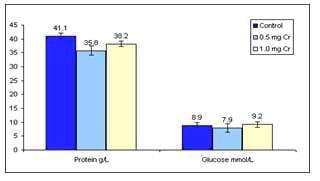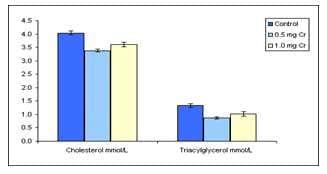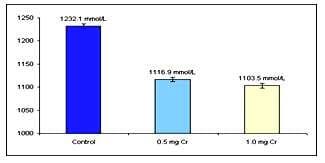Chromium picolinate can improve growth and feed efficiency in heat-stressed broilers
Published: May 4, 2010
By: Sudipto Haldar
Importance of chromium as a dietary supplement
Reducing stress in poultry remains a topic of concern amongst producers and scientists. An increased concentration of glucose in blood and a decreased protein level are associated with stress induction along with an increase in circulatory cortisol level. A temperature >30oC represents a heat-stressed condition for birds and is one of the most common stressors that affect the production criteria in poultry in the Indian subcontinent. Methods to alleviate the effect of heat stress focus on manipulating the diet. Trivalent chromium (Cr3+) may be used as one of the tools to handle such stress situation. Recommendation with regards to the exact inclusion level of Cr in diet is not yet available. Nevertheless, dietary Cr supplementation is coming as a new feeding management tool.
Cr picolinate is perhaps the most widely explored compound in research work conducted on Cr. By virtue of a different absorptive pathway, Cr picolinate is more bio-effective than inorganic compounds like Cr chloride. The present experiment was conducted to assess the efficacy of Cr picolinate as a dietary supplement for heat-stressed broiler chickens.
Bird husbandry and dietary treatments
Cobb 400 broiler chickens (n = 225), obtained 12 h post hatch from a local hatchery, were supplemented with 0 (control), 0.5 mg and 1.0 mg Cr as Cr picolinate from 10 to 40 days of age. A flock of 15 chicks was slaughtered on day 1 for assessing the blood metabolite profile and carcass traits at the pre experimental stage. The birds were placed in pens (1.5 m x 1.5 m) on litter floors. The pens, each housing 10 birds, were the replicates and there were 7 replicates in each treatment group. The birds were fed a basal starter diet till day 10 and Cr was supplemented to the diet as Cr picolinate from day 11 onwards. The starter diet was fed to day 30 and a finisher diet for the remaining period. Temperature inside the experimental room was kept at 35-36oC throughout the experimental period to put the birds under a moderately heat stressed condition which was evidenced by panting and dispersed distribution of the birds within the pens.
Blood was collected on day 1 during the initial slaughter and on day 40 prior to the final slaughter. Birds were fed ad libitum during the starter phase (d 1-30) but physical feed restriction was imposed during the finisher (d 31-40) phase. Gross carcass traits including the carcass yield was determined. Meat was analyzed for ash, protein and fat in the carcass obtained on days 1 and 40 and the total accretion of the said nutrients was calculated. The efficiency of protein utilization in terms of live weight gain per unit protein consumed and the protein conversion efficiency expressed in terms of protein intake for each unit of protein accretion was calculated.
Benefits of Cr supplementation
The results of the present experiment indicated that dietary Cr supplementation may improve the performance and carcass traits of the broiler chickens and the effects were perhaps mediated through the effect that Cr had in reducing the circulatory cortisol level.
Table 1. Ingredients and chemical composition of the basal diet
Ingredients | Starter | Grower |
CornSoybean meal Sunflower cake Fat Salt Dicalcium Phosphate Lysine sulfate DL Methionine Trace mineralsa Maduramycin Enzymes Ascorbic acid Toxin binder Organic acids Vitamins | 580 351.3 24 30 1.5 8.8 0.3 0.8 1.5 0.5 0.26 0.1 1 1 0.27 | 620 322 - 40 1.5 9.5 1.6 1.3 1 0.5 0.26 0.1 1 1 0.27 |
Total, kg | 1000 | 1000 |
Nutrients, DM basisProtein, % ME, Kcal/kg Lysine, % Methionine, % M+C, % Calcium, % Available P, % Chromium, mg | 21.0 3083 1.3 0.5 0.73 0.35 0.31 0.18 | 19.4 3203 1.2 0.5 0.68 0.42 0.37 0.20 |
a Contained (kg -1) manganese 40 mg, iron, 30 mg, zinc 25 mg, copper 3.5 mg, iodine 0.3 mg, selenium 0.15 mg, choline chloride 200 mg
BENEFICIAL EFFECTS OF DIETARY CHROMIUM SUPPLEMENTATION AS CHROMIUM PICOLINATE |

Figure 1: Live weight (kg), live weight gain and FCR Figure 3: Yield (g) of dressed carcass, breast and legs

Figure 2: Live weight gain at different age intervals Figure 4: Protein utilization and conversion efficiency
Cr supplementation in the form of Cr picolinate was found to be beneficial in terms of all the performance and carcass related traits studied in this investigation. Interestingly, the dose level of 0.5 mg Cr kg-1 diet was found to have elicited superior effects compared to the higher dose level of 1.0 mg Cr kg-1 diet. The final live weight and the total live weight gain in 40 days increased significantly (P<0.05) due to Cr supplementation (Figure 1). Consequently the cumulative feed conversion efficiency (FCR) also improved when the birds received dietary Cr supplementation (P<0.05).
Live weight gain was similar across the dietary treatments during the starter phase (1-30 days of age) and hence the utilization efficiency for energy and protein also did not differ due to Cr supplementation during the starter phase. However, as the birds moved on to the finisher stage (31-40 d of age), their response changed (Figure 2). Birds receiving Cr supplementation gained more (P<0.05) body weight during the age interval of 31-40 days compared to the control group of birds. As a result, the efficiency of energy and protein utilization also improved (P<0.05) during that phase (Table 2). This is especially important because it was during this stage of growth when physical feed restriction was imposed. The study, therefore, indicated that supplementation of Cr picolinate may help the birds in utilizing the nutrients to a greater extent which ought to yield better economic return for the farmers.
Hot carcass weight and eviscerated carcass weight improved (P<0.05) due to Cr supplementation and the effects were heavier in those receiving 0.5 Cr daily. Weight of the whole breast increased (P<0.05) and those of the frame and the legs tended to increase (P<0.1) when Cr was supplemented to the diet. However, carcass yield was not affected by dietary Cr supplementation.
The fat content of the meat decreased (P<0.05) while protein accretion from 1-40 d increased (P<0.05) due to Cr supplementation. Hence, Cr picolinate has been found to be effective in reducing carcass fat and increasing lean meat production. The efficiency of protein conversion to meat protein also improved due to Cr supplementation with the birds receiving 0.5 mg supplemental Cr showing significantly higher efficiency across the dietary treatment groups (Table 2).
Table 2. Yield of carcass components, chemical composition, nutrient accretion and efficiency of protein conversion in broiler chickens supplemented with graded doses of Cr
Measurement | Chromium, mg/kg diet | Pooled SE | Significance | ||
0 | 0.5 | 1.0 | |||
Yielda Breast Frame Legs Carcass yieldb Moisture Ash Crude protein Ether extract Protein accretion Fat accretion Ash accretion Protein intake g: Protein accretion g (1-40 days) | 32 24 36 60 712 120.2 21.6 7.4 317.5 109.9 175.9 1.85 | 33 23 34 62 724 119.9 22.7 6.3 389.1 107.1 204.8 1.52 | 30 25 35 61 724 120.2 21.9 6.5 344.5 100.9 188.6 1.74 | 0.51 0.36 0.34 0.58 1.3 3.17 0.37 0.25 8.79 3.95 6.69 0.04 | * * NS NS ** NS NS* ** * NS NS ** |
Each treatment group consisted of 7 replicates of 10 Cobb 400 unsexed broiler chickens with a mean live weight of 41.4±0.23 g at 12 h post hatch. Slaughter was performed after 40 days feeding trial by taking 2 birds at random from all the 7 replicates under each treatment group. The data were pooled replicate wise for calculation and statistical analyses. a Weight of the breast, frame and legs relative to the eviscerated carcass weight. b Defined as weight of the feather picked eviscerated carcass (with the blood, head, neck and hock removed) relative to the live weight. * NS, non significant
EFFECTS OF SERUM METABOLITES AND CIRCULATORY CORTISOL IN BROILER CHICKENS |

Figure 5 (a) Circulatory serum protein (g l-1) and glucose (mmol L-1) level

Figure 5 (b) Circulatory serum cholesterol and tryacylglycerol (mmol L-1)

Figure 5 (c) Circulatory cortisol concentrations (n mol L-1)
Measurement of serum metabolites revealed a significant decline in circulatory protein concentration in the chickens receiving dietary Cr supplementation (P<0.05). This may be due to an enhanced utilization of absorbed protein for conversion into tissue protein. On the other hand, the lower (P<0.05) circulatory glucose concentration in the Cr supplemented birds was perhaps indicative of an increased turn over rate and utilization of glucose at the tissue level. The higher glucose level in the control group of birds might be due to the heat stress the birds had to encounter during the course of the experiment and the results, therefore, further bolstered the stress alleviating effects of supplemental Cr (Figure 5 a).
The most intriguing aspect of the present study was the circulatory lipid lowering effect of circulatory Cr (Table 5 b). Relative to the control group of birds' serum cholesterol and tryacylglycerol concentrations were significantly lower when 0.5 mg Cr was supplemented to the diet (P<0.05).
All the above findings may get an explanation from the circulatory cortisol level (Figure 5 c) which was reduced when the birds received supplemental Cr (P<0.05). However, it is difficult to explain the lack of linearity in dose response. However, it has been reported earlier [10] that like many other trace elements Cr may also have a "zone of biological action" and elicits significant dose response only up to a certain dose level beyond which no beneficial effect of supplementation could be obtained.
The present study, therefore, indicated that supplementation of Cr in the form of Cr picolinate may be used as an effective tool for alleviating heat stress in nutritionally restricted broiler chickens. The effects are mediated via a cortsol lowering effect of Cr which shifts the balance more towards anabolism leading to a greater nutrient utilization efficiency and production of lean meat.
Hence, it may be recommended that inclusion of 0.5 mg Cr as chromium picolinate per kg diet may be considered as a new and innovative tool for a better and efficient feeding management tool.
A list of references is available from the author
________________________________________________________________________________________________
The article was published in The March 2008 issue of Asian Poultry Magazine
Related topics:
Authors:
Recommend
Comment
Share
Mianyang Sinyiml Chemical
30 de octubre de 2012
Sudipto Haldar
Thank you for supplying us a good article about chromium's effect on poultry.
John
Recommend
Reply

Would you like to discuss another topic? Create a new post to engage with experts in the community.









.jpg&w=3840&q=75)